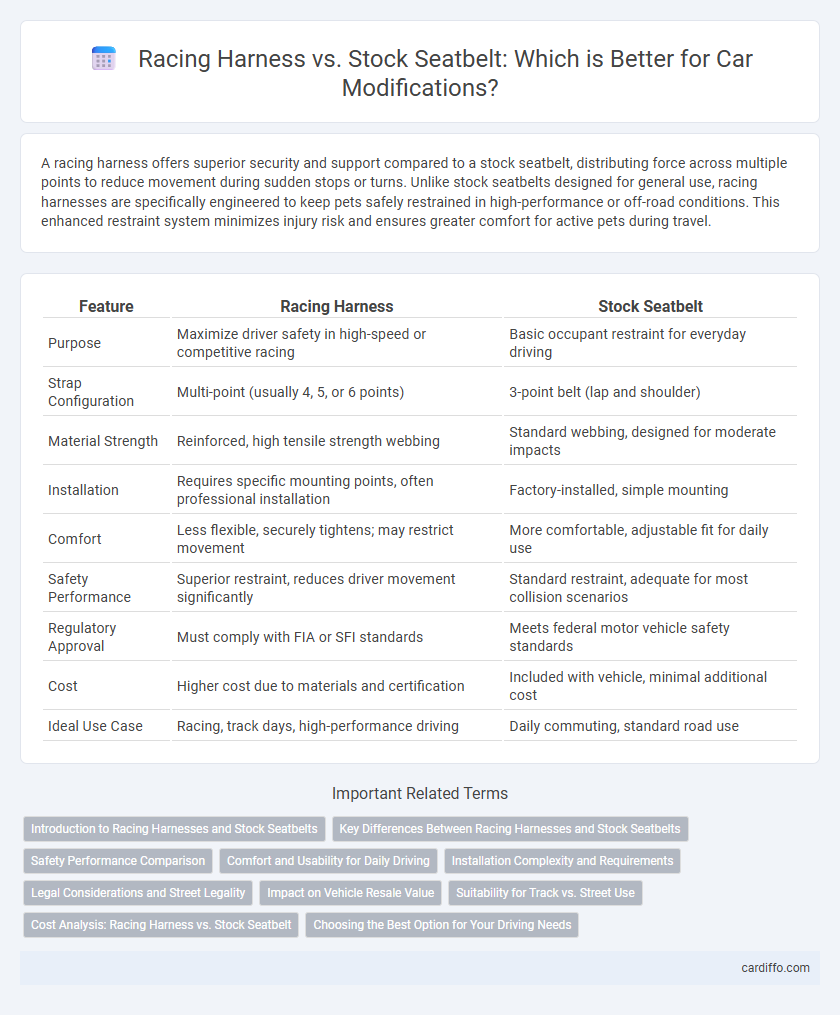A racing harness offers superior security and support compared to a stock seatbelt, distributing force across multiple points to reduce movement during sudden stops or turns. Unlike stock seatbelts designed for general use, racing harnesses are specifically engineered to keep pets safely restrained in high-performance or off-road conditions. This enhanced restraint system minimizes injury risk and ensures greater comfort for active pets during travel.
Table of Comparison
| Feature | Racing Harness | Stock Seatbelt |
|---|---|---|
| Purpose | Maximize driver safety in high-speed or competitive racing | Basic occupant restraint for everyday driving |
| Strap Configuration | Multi-point (usually 4, 5, or 6 points) | 3-point belt (lap and shoulder) |
| Material Strength | Reinforced, high tensile strength webbing | Standard webbing, designed for moderate impacts |
| Installation | Requires specific mounting points, often professional installation | Factory-installed, simple mounting |
| Comfort | Less flexible, securely tightens; may restrict movement | More comfortable, adjustable fit for daily use |
| Safety Performance | Superior restraint, reduces driver movement significantly | Standard restraint, adequate for most collision scenarios |
| Regulatory Approval | Must comply with FIA or SFI standards | Meets federal motor vehicle safety standards |
| Cost | Higher cost due to materials and certification | Included with vehicle, minimal additional cost |
| Ideal Use Case | Racing, track days, high-performance driving | Daily commuting, standard road use |
Introduction to Racing Harnesses and Stock Seatbelts
Racing harnesses provide superior support and safety compared to stock seatbelts by distributing impact force across the driver's body during high-speed events. These harnesses typically feature multiple attachment points, such as 4-point or 6-point systems, enhancing restraint and minimizing driver movement. Stock seatbelts, often 3-point belts, offer adequate protection for everyday driving but lack the specialized design needed for performance racing scenarios.
Key Differences Between Racing Harnesses and Stock Seatbelts
Racing harnesses provide multiple points of restraint, typically 4, 5, or 6-point systems, offering enhanced stability and safety during high-speed maneuvers compared to the standard 3-point design of stock seatbelts. Unlike stock seatbelts with a simple lap and shoulder belt, racing harnesses also incorporate wider straps and more secure mounting points to distribute forces evenly across the body, reducing injury risk in collisions. The rigid installation and adjustable tension of racing harnesses optimize driver movement control, whereas stock seatbelts prioritize everyday comfort and ease of use.
Safety Performance Comparison
Racing harnesses provide superior safety performance compared to stock seatbelts by offering multiple points of restraint, typically five or six, which distribute crash forces more evenly across the body. This design minimizes movement during high-impact collisions, reducing the risk of injury in motorsport environments. Unlike standard seatbelts that primarily secure the lap and shoulder, racing harnesses also prevent lateral and vertical motion, enhancing overall occupant protection.
Comfort and Usability for Daily Driving
Racing harnesses provide superior restraint and support compared to stock seatbelts but often sacrifice comfort due to tighter fit and restrictive movement, making them less ideal for daily driving. Stock seatbelts are designed for ease of use and comfort, allowing freedom of movement and quick adjustments, which enhances usability in everyday scenarios. For daily driving, stock seatbelts offer a practical balance between safety and comfort, whereas racing harnesses are better suited for track use and performance-oriented environments.
Installation Complexity and Requirements
Racing harness installation demands specialized mounting points and reinforcement to ensure safety compliance, unlike stock seatbelts that utilize pre-existing OEM anchors designed for quick fitting. Proper harness setup often requires tools for custom bracket fabrication and sometimes professional installation to avoid compromising vehicle integrity. Stock seatbelts offer straightforward installation with minimal adjustments due to manufacturer-engineered design compatibility.
Legal Considerations and Street Legality
Racing harnesses often lack street legality due to failing to meet federal safety standards mandated for stock seatbelts, such as FMVSS 209 and FMVSS 208 compliance. Many jurisdictions prohibit the use of racing harnesses on public roads because they can interfere with airbags and seatbelt pretensioners designed for factory seatbelts. Vehicle owners must verify local laws and regulations before replacing stock seatbelts with racing harnesses to avoid legal penalties and ensure occupant safety.
Impact on Vehicle Resale Value
Upgrading to a racing harness can enhance vehicle safety and appeal to performance-focused buyers, potentially increasing resale value in niche markets. However, stock seatbelts maintain original equipment manufacturer (OEM) compliance, preserving broader market appeal and easier vehicle inspections. Modifications like racing harnesses may deter some buyers concerned with legality and insurance, impacting overall resale value negatively.
Suitability for Track vs. Street Use
Racing harnesses offer superior restraint and safety for track use by securely holding the driver in place during high-speed maneuvers, reducing the risk of injury in crashes. Stock seatbelts are designed for street use, providing adequate protection in everyday driving conditions with easier mobility and comfort. While racing harnesses excel on the track, their limited adjustability and bulkiness make them less practical and potentially unsafe for regular street driving.
Cost Analysis: Racing Harness vs. Stock Seatbelt
Racing harnesses typically range from $150 to $400, presenting a higher upfront cost compared to stock seatbelts, which usually cost between $20 and $70. Installation expenses for racing harnesses can add $100 to $200 due to the need for professional fitting and additional mounting hardware, whereas stock seatbelts often require minimal or no installation fees. While racing harnesses offer enhanced safety and performance benefits, their total expenditure is significantly greater than the relatively inexpensive and easily replaceable stock seatbelt systems.
Choosing the Best Option for Your Driving Needs
Choosing the best option between a racing harness and a stock seatbelt depends on your driving style and safety requirements. Racing harnesses provide superior restraint and reduce driver movement during high-speed or competitive driving, enhancing control and crash protection. Stock seatbelts offer adequate safety for everyday driving with easier use and compatibility in standard vehicles.
racing harness vs stock seatbelt Infographic

 cardiffo.com
cardiffo.com